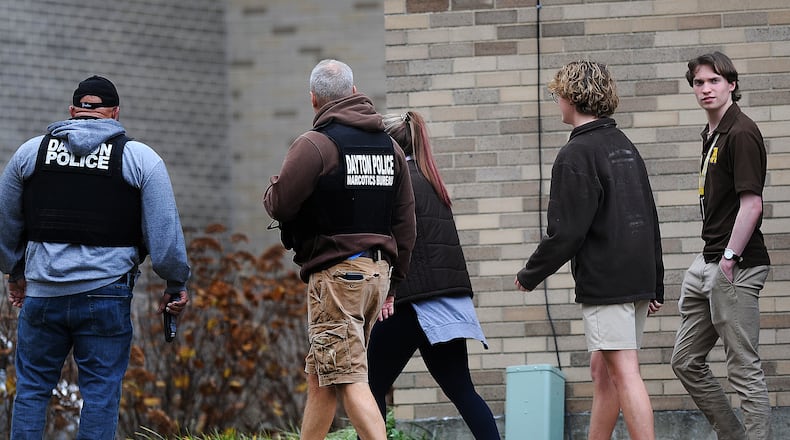Two recent but separate incidents were in the news over the last two weeks.
Paul Gaspure Chirco, of Dayton, is facing charges for allegedly leaving racist graffiti on a local school and making bomb threats.
Chirco was identified as the suspect in multiple cases of damaging DECA Prep elementary school in Dayton.
Graffiti included a bomb threat with a racial slur, as well as the phrase “Decca Academy sucks get out or die!” were found at the school.
Chirco is a suspect in numerous cases of criminal damaging and calling in false bomb threats, including to the RTA bus hub.
Chirco was booked in the Montgomery County Jail on initial charges of swatting, inducing panic and making false alarms.
Tmyah Whiters, of West Chester, is accused of making three false calls to 911 about a shooter last month in Dayton.
Credit: Lynch, Gregory
Credit: Lynch, Gregory
The first reported that a person had a gun and assaulted her and would shoot law enforcement. The second call said the shooter would shoot any responding officers, and the third call said the shooter had killed everyone in the house, the prosecutor’s office said.
Whiters is scheduled to be arraigned July 23 in Montgomery County Common Pleas Court for swatting and a misdemeanor charge of making false alarms.
Other recent examples
In November 2023 Kettering police investigated a false report of gunfire outside Alter High School.
The caller claimed there was a student with a handgun in a classroom who shot six students in a classroom. He said he was hiding inside a classroom at the school and had locked the door.
Similar false calls were reported at other Ohio and Kentucky schools that same morning.
In February 2022, a 14-year-old Huber Heights boy was accused of making “swatting” calls, including bomb threats that evacuated two businesses and a third call claiming he would kill his mother and himself.
In September 2022, law enforcement were sent to Belmont High School in Dayton and Catholic Central High School in Springfield on the same day due to false threats of a school shooter. A 12-year-old student was charged in connection with the hoax call of an active shooter at Catholic Central. Police arrested the girl on a charge of inducing panic.
In March, Thurgood Marshall High School was placed in a brief “shelter in place” after a false 911 call reporting a shooting at the school.
Also in March, Clark County Sheriff’s deputies rushed to Kenton Ridge High School after a 911 caller reported falsely that someone entered a restroom and shot students.
The damage it causes
While some may see this activity as a harmless prank, others know there are harmful repercussions.
“As all of you know this becomes a mental health issue where they need to process and to send them back to class I felt would be irresponsible of us,” Alter Principal Lourdes Lambert said. “We do have counselors in the building to speak to them, but I know that they would want to go home and debrief with their families.”
Multiple parents went to Alter after receiving a one-call about the incident. Other parents texted their children to make sure they were alright.
Parent Allison Shillito went to the high school to try and learn more about what was going on.
“I’m so thankful everybody is safe,” she said. “But it’s still very scary just to know all the kids are in there and who knows what they’re thinking.”
A spokeswoman for the Montgomery County Sheriff’s Office recently said: “Innocent individuals who are swatted often experience trauma, fear, and distress. It can also lead to unnecessary damage to property, endangerment of bystanders, and more.”
Swatting also ties up emergency services, sometimes limiting their ability to respond to other incidents.
Changes in the law
Kettering police Chief Chip Protsman said that due to the increase in false school threats and false school shooting reports additional laws have been passed to increase penalties.
A change in Ohio law that started April 3 allows prosecutors to issue a felony charge of swatting against those who deliberately call or text law enforcement with false school threats. If found guilty, the offender can be required to pay back the fees associated with law enforcement going to the false threat.
The change in Ohio law came from the passage of House Bill 462, which made swatting a fourth-degree felony.





